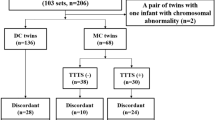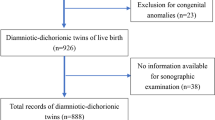Abstract
Background:
Monochorionic monoamniotic twins (MoMo) occur in one of 10 000 pregnancies. Cord entanglement, malformations, twin-to-twin transfusion syndrome (TTS) and prematurity are responsible for their high perinatal morbidity and mortality.
Objective:
To report our experience with 36 sets of MoMo twins (1990 to 2005) and to provide updated information for counseling.
Methods:
Chorionicity was determined by placental examination, gestational age and TTS clinically and by sonography. Intrauterine growth restriction (IUGR) was diagnosed with a twin-specific nomogram.
Results:
Cord entanglement was observed in 15 pregnancies, but only one twin with entanglement and a true knot, experienced related morbidity. Four of 71 live births were IUGR. Malformations were diagnosed prenatally (one hypoplastic left heart and one body stalk) and postnatally (one vertebral anomalies-anal atresia-tracheoesophageal fistula-renal defect (VATER) and two lung hypoplasias). Twin-to-twin transfusion syndrome affected three sets of twins. Five twin sets delivered before 31, 19 sets at 31 to 32 and 12 sets at 33 to 34 weeks. Six of 71 (8%) twins died (four malformations, one TTS and one 26 weeks premature). Head ultrasounds in 59 of 65 survivors showed two (3%) periventricular leukomalacia, five (9%) Grade I–II intraventricular hemorrhage and 52 (88%) normal.
Conclusions:
Monochorionic monoamniotic twins remain a group at risk for cord entanglement, congenital malformations, TTS and prematurity. Although their neonatal mortality and morbidity is high, outcomes for survival are better than anticipated.
This is a preview of subscription content, access via your institution
Access options
Subscribe to this journal
Receive 12 print issues and online access
$259.00 per year
only $21.58 per issue
Buy this article
- Purchase on Springer Link
- Instant access to full article PDF
Prices may be subject to local taxes which are calculated during checkout
Similar content being viewed by others
References
Martin JA, Hamilton BE, Sutton PD, Ventura SJ, Menacker F, Munson M . Birth: final data for 2002. Natl Vital Stat Rep 2003; 52: 1–27.
Powers WF, Kiely JL . The risks confronting twins: a national perspective. Am J Obstet Gynecol 1994; 170: 456–461.
Benirschke K . The biology of the twinning process: how placentation influences outcome. Semin Perinatol 1995; 19: 342–350.
Carr SR, Aronson MP, Coustan DR . Survival rates of monoamniotic twins do not decrease after 30 weeks' gestation. Am J Obstet Gynecol 1990; 163: 719–722.
Tessen JA, Zlatnik FJ . Monoamniotic twins: a retrospective controlled study. Obstet Gynecol 1991; 77: 832–834.
Victoria A, Mora G, Arias F . Perinatal outcome, placental pathology, and severity of discordance in monochorionic and dichorionic twins. Obstet Gynecol 2001; 97: 310–315.
Dube J, Dodds L, Armson BA . Does chorionicity or zygosity predict adverse perinatal outcomes in twins? Am J Obstet Gynecol 2002; 186: 579–583.
Umur A, Van Gemert M, Nikkels P . Monoamniotic-versus diamniotic-monochorionic twin placentas: anastomoses and twin–twin transfusion syndrome. Am J Obstet Gynecol 2003; 189: 1325–1329.
Gallot D, Saulnier JR, Savary D, Laurichesse-Delmas H, Lemery D . Ultrasonographic signs of twin-twin transfusion syndrome in a monoamniotic twin pregnancy. Ultrasound Obstet Gynecol 2005; 25: 307–311.
Quintero RA, Morales WJ, Allen MH, Bornick PW, Johnson PK, Kruger M . Staging of twin–twin transfusion syndrome. J Perinatol 1999; 19: 550–555.
Harman CR . Assessment of fetal health. In: Creasy RK, Resnik R, Iams JD (eds). Maternal–Fetal Medicine: Principles and Practice. Saunders: Philadelphia, PA, 2004, pp 357–401.
Ananth CV, Vintzileo AM, Shen-Schwarz S, Smulian JC, Lai YL . Standards of birth weight in twin gestations stratified by placental chorionicity. Obstet Gynecol 1998; 91: 917–924.
Papile LA, Burstein J, Burstein R, Koffler H . Incidence and evolution of the subependymal intraventricular hemorrhage: a study of infants with weights less than 1500 g. J Pediatr 1978; 92: 529–534.
Baldwin V . The pathology of monochorionic monozygosity. In: Baldwin V (ed). Pathology of Multiple Pregnancy. Springer-Verlag: New York, 1994, pp 199–213.
Bilardo CM, Arabin B . Monoamniotic twins. In: Blickstein I, Keith LG (eds). Multiple Pregnancy. Taylor & Francis: London and New York, 2005, pp 574–582.
Rodis JF, McIlveen PF, Eagen JF, Borgida AF, Turner GW, Campbell WA . Monoamniotic twins: improved perinatal survival with accurate prenatal diagnosis and antenatal fetal surveillance. Am J Obstet Gynecol 1997; 177: 1046–1049.
Allen VM, Windrim R, Barrett J, Ohlsson A . Management of monoamniotic twin pregnancies: a case series and systematic review of the literature. Br J Obstet Gynecol 2001; 108: 931–936.
Roque H, Gillen-Goldstein J, Funai E, Young BK, Lockwood CJ . Perinatal outcomes in monoamniotic gestations. J Matern-Fetal Neonat Med 2003; 13: 414–421.
Ezra Y, Shveiky D, Ophir E, Nadjari M, Eisenberg VH, Samueloff A et al. Intensive management and early delivery reduce antenatal mortality in monoamniotic twin pregnancies. Acta Obstet Gynecol Scand 2005; 84: 432–435.
Bajoria R . Vascular anatomy of monochorionic placenta in relation to discordant growth and amniotic fluid volume. Hum Reprod 1998; 13: 2933–2940.
Demaria F, Goffinet F, Kayem G, Tsatsaris V, Hessabi M, Cabrol D . Monoamniotic twin pregnancies: Antenatal management and perinatal results of 19 consecutive cases. Int J Obstet Gynecol 2004; 111: 22–26.
Suzuki S, Kaneko K, Shin S, Araki T . Incidence of intrauterine complications in monoamniotic twin gestation. Arch Gynecol Obstet 2001; 265: 57–59.
Ananth CV, Smulian JC . Trends in congenital malformations, chromosomal anomalies and infant mortality among twin birth. In: Blickstein I, Keith LG (eds). Multiple Pregnancy. Taylor & Francis: London and New York, 2005, pp 246–251.
Mastroiacovo P, Castilla EE, Arpino C, Botting B, Cocchi G, Goujard J et al. Congenital malformations in twins: an international study. Am J Med Genet 1999; 83: 117–124.
Smrcek JM, Germer U, Krokowski M, Berg C, Krapp M, Geipel A et al. Prenatal ultrasound diagnosis and management of body stalk anomaly: analysis of 9 singleton and 2 multiple pregnancies. Ultrasound Obstet Gynecol 2003; 21: 322–328.
Sebire NJ, Souka A, Skentou H, Geerts L, Nicolaides KH . First trimester diagnosis of monoamniotic twin pregnancies. Ultrasound Obstet Gynecol 2000; 16: 223–225.
McIntire D, Bloom SL, Casey BM, Leveno KJ . birth weight in relation to morbidity and mortality among newborn infants. N Engl J Med 1999; 340: 1234–1238.
Author information
Authors and Affiliations
Corresponding author
Rights and permissions
About this article
Cite this article
Cordero, L., Franco, A. & Joy, S. Monochorionic monoamniotic twins: neonatal outcome. J Perinatol 26, 170–175 (2006). https://doi.org/10.1038/sj.jp.7211457
Received:
Revised:
Accepted:
Published:
Issue Date:
DOI: https://doi.org/10.1038/sj.jp.7211457
Keywords
This article is cited by
-
Cord Blood Proteomic Biomarkers for Predicting Adverse Neurodevelopmental Outcomes in Monoamniotic Twins
Reproductive Sciences (2022)
-
Perinatal mortality and morbidity, timing and route of delivery in monoamniotic twin pregnancies: a retrospective cohort study
Archives of Gynecology and Obstetrics (2021)
-
Neurodevelopmental outcome of preterm twins at 5 years of age
Pediatric Research (2020)
-
Familial occurrence of the VATER/VACTERL association
Pediatric Surgery International (2012)
-
Fetal MRI of conjoined twins who switched their relative positions
Pediatric Radiology (2010)



